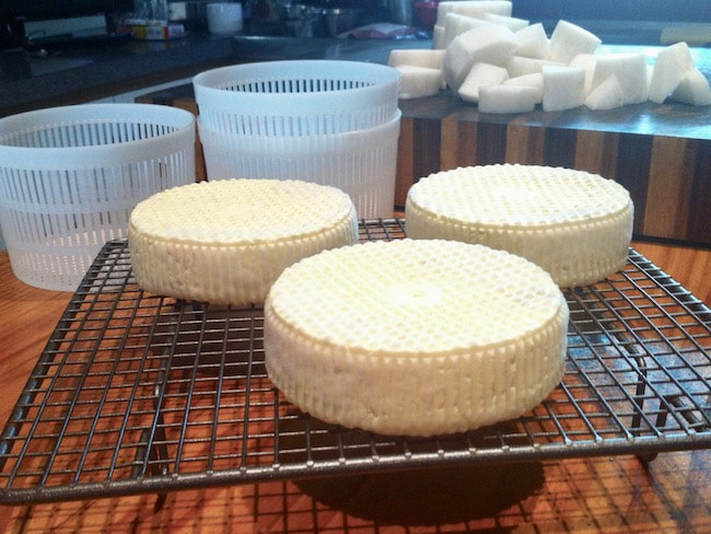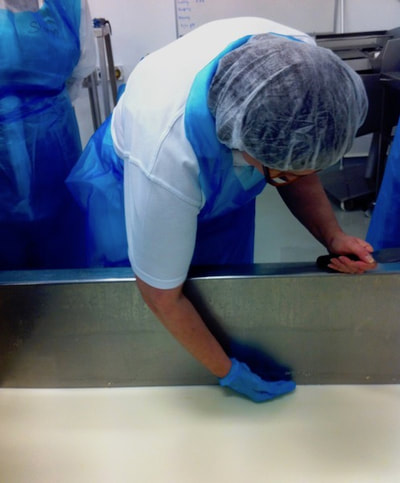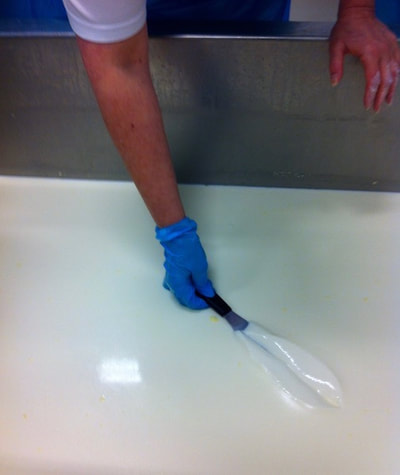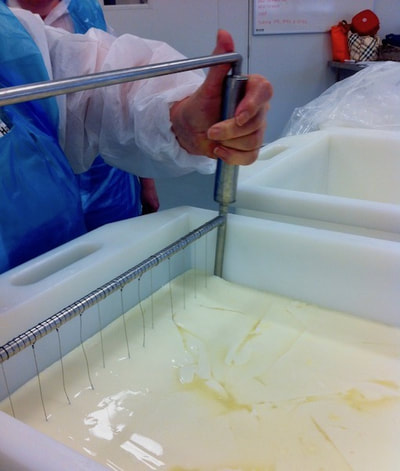 Yes dear reader, I made these - 3 Camembert-style rounds, just before their "fur" starts to grow. Some time ago, friend Rosa and I took the plunge and enrolled in a day course of cheese-making. It was designed as a refresher for the industry or an introduction for the beginner. We were certainly the latter. It was a TAFE course which meant that we were not leant upon to purchase "stuff". The group was separated into three groups, soft cheeses such as Brie and Camembert, hard Cheddar-like cheese and blues. We were soft. We were lead by Gina Dal Santo, an autodidact who now is not only the S.A. TAFE cheese lecturer but a nationally recognised speaker, trainer and judge in this area. My photographs are sketchy - chosen for anonymity because the cheese-making garb is very unflattering. A white overall, blue plastic apron, white rubber boots and best of all a hairnet made of what looked like Chux. If we had to leave the space, we walked through an antibacterial liquid and we washed our hands and slathered on antibacterial lotion about every five minutes. But for two gastronomes and cheese lovers, what a fun day! Straight up, I can say that sending someone on a cheese-making day could be the best present (birthday or otherwise). Even one of those evenings where you go home with a little kit which makes one tiny Camembert, could open up a whole new world of entertainment. Even if we never made cheese ourselves, the experience was invaluable in teaching a respect and new appreciation for the process. We learn't that milk is broken down into curds and whey, whey being the watery part. The whey makes up 60-70% of the final product. The whey can be fed to animals, used as a liquid in cooking (e.g. soups) or saved and made into ricotta (ricotta = re-cooked). This day, the whey was discarded, the plug at the bottom of the vats removed and the whey allowed to run out. The floor of the cheese room was a totally flat stainless steel "sink", with intermittent drain holes. No wonder we sloshed around in our rubber boots. This loss accounts for some of the high cost of cheese (and I'll never complain again). We learn't that we could make small batches of certain cheeses at home, while others styles might require equipment like presses and temperature-controlled cellars. Once home, I knew I could do this and contacted CheeseLinks (Cheeselinks) for some "ingredients" (small vials, easily stored in freezer or refrigerator).
I recommend CheeseLinks and also a new book "Curd and Crust" by Tamara Newing ( and of course our favourite cheese-master, Mr Google.) When I make a batch, I spend a morning with my curds. It's not hard work, just some waiting around. I do five litres of milk at a time and make the following... 3 beautiful Camembert style rounds OR 3 triple cream OR 3 chèvre (Goat, to us. Have not been able to get hold of sheets' milk yet.) OR Wonderful feta (because I control the salt) OR Haloumi - excellent grilled My washed rind is still a work in process, as is the bleu cheese. (The blue seems to grow on the outside rather than inside). Imagine a cheese plate where, along with the blue and cheddar style, there is one round made by you. Next post, next week, a step by step through my cheese making morning.
0 Comments
Leave a Reply. |
Categories
All
|



 RSS Feed
RSS Feed
